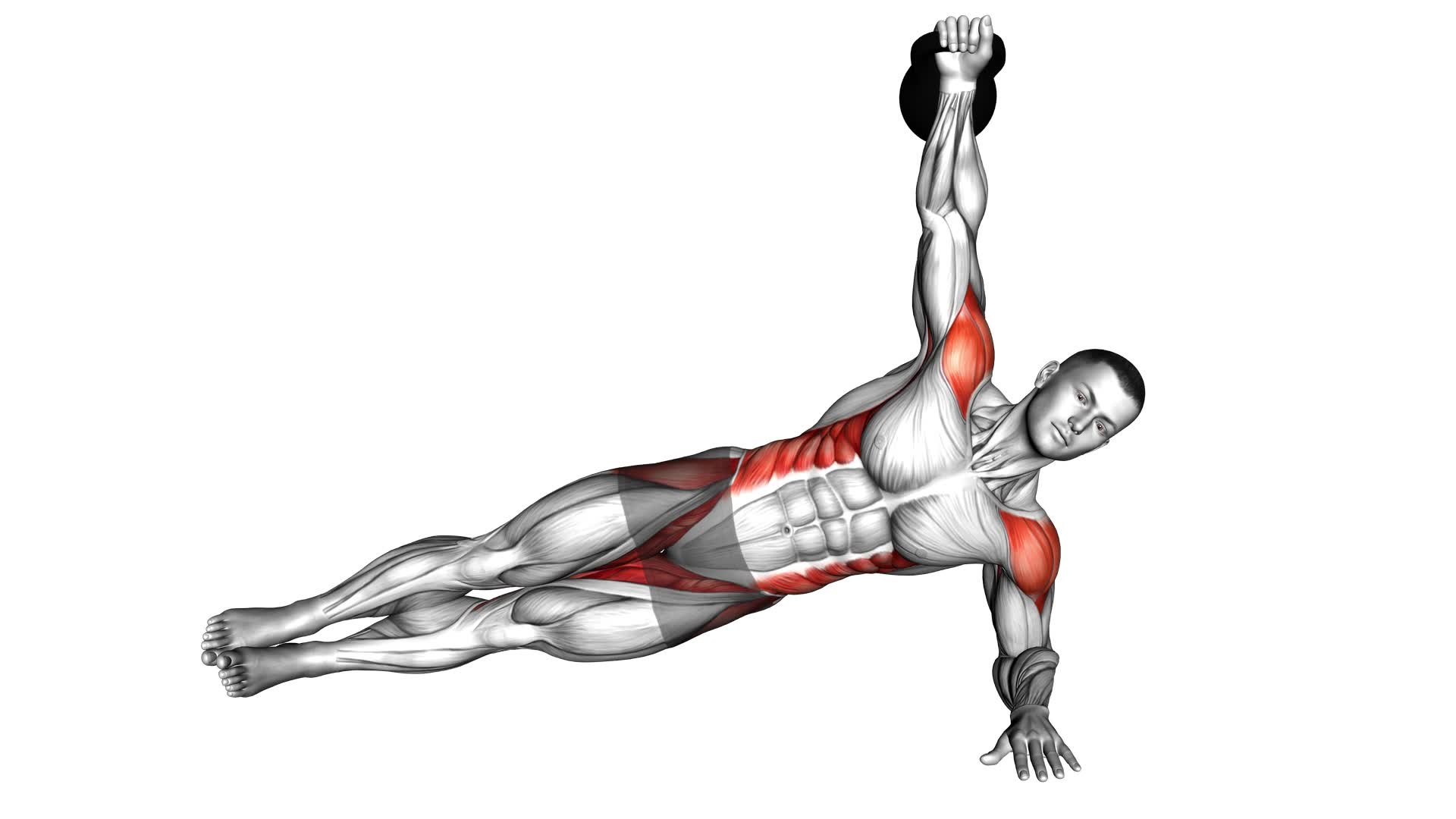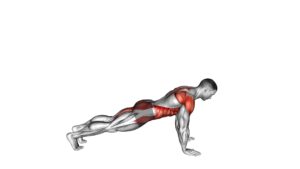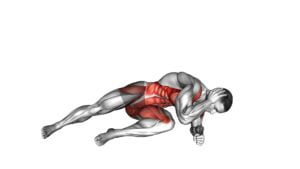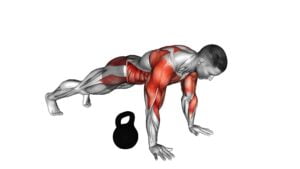Kettlebell Side Plank (male) – Video Exercise Guide & Tips

Looking to strengthen your core and improve your stability? Look no further than the kettlebell side plank.
Watch This Exercise Video
In this video exercise guide, we'll show you the proper form and technique for this challenging move. Whether you're a beginner or an experienced fitness enthusiast, we've got modifications for all fitness levels.
Avoid common mistakes and maximize your results with our helpful tips.
Get ready to feel the burn with the kettlebell side plank. Let's do this!
Key Takeaways
- Kettlebell side plank improves core strength and stability
- Proper form and technique are important for maximizing effectiveness and minimizing the risk of injury
- Modifications can be made to tailor the exercise to different fitness levels
- Consistency in following the workout routine is crucial for better results
Benefits of Kettlebell Side Plank
To fully understand the benefits of the Kettlebell Side Plank, you should know that it can greatly improve your core strength and stability. This exercise specifically targets your obliques, which are the muscles on the sides of your abdomen. By engaging these muscles, you can enhance your stability and overall strength.
The Kettlebell Side Plank is an effective way to improve stability because it requires you to balance your body weight on one arm while holding a kettlebell in the other hand. This challenge forces your core muscles to work harder to maintain proper alignment and prevent any wobbling or tipping. As a result, your core strength increases, and you become more stable in various movements and activities.
Additionally, targeting your obliques with the Kettlebell Side Plank can have several benefits. These muscles play a crucial role in rotational movements and lateral flexion of the spine. By strengthening them, you can improve your ability to twist and turn your body with control and power. This can be particularly useful in sports that involve twisting motions, such as golf or tennis.
Proper Form and Technique
To properly execute the Kettlebell Side Plank, you'll need to position your body in a straight line, with one arm supporting your weight and a kettlebell in the other hand. Here are some important tips to ensure proper form and technique:
- Engage your core: Before lifting your body off the ground, engage your core muscles by pulling your belly button in towards your spine. This will help stabilize your body throughout the exercise.
- Maintain a straight line: Your body should form a straight line from your head to your heels. Avoid sagging or arching your back, as this can put unnecessary strain on your lower back.
- Breathe deeply: Focus on the importance of breathing during the exercise. Inhale deeply through your nose, allowing your ribcage to expand. Exhale fully through your mouth, engaging your core muscles even more.
- Add variations for added difficulty: Once you have mastered the basic Kettlebell Side Plank, you can try adding variations to challenge yourself further. This can include lifting your top leg, extending your top arm overhead, or even adding a hip dip motion.
Remember to start with a weight that you can handle comfortably and gradually increase the difficulty as you get stronger. By maintaining proper form and technique, you'll maximize the benefits of the Kettlebell Side Plank exercise.
Modifications for Different Fitness Levels
If you're looking to modify the Kettlebell Side Plank exercise for different fitness levels, consider using alternative variations that suit your abilities. There are progression options and advanced modifications available to challenge yourself or to make the exercise more accessible.
For beginners or those with limited core strength, you can start with a regular side plank without the kettlebell. Focus on maintaining a proper alignment and engaging your core muscles. Once you feel comfortable, you can gradually add the kettlebell to increase the intensity.
For intermediate fitness levels, you can try lifting the top leg while holding the side plank position. This will further engage your core and challenge your balance.
Advanced modifications include performing the side plank with an extended arm, or lifting the top leg and arm simultaneously. These variations require more strength and stability, so make sure you have mastered the basic side plank before attempting them.
By modifying the Kettlebell Side Plank exercise, you can tailor it to your fitness level and gradually progress as you become stronger. Remember to always listen to your body and choose variations that challenge you without causing any pain or discomfort.
Now let's move on to the next section and discuss common mistakes to avoid when performing the Kettlebell Side Plank exercise.
Common Mistakes to Avoid
To perform the kettlebell side plank correctly, it's important to maintain proper body alignment. Keep your body in a straight line from head to toe, avoiding any sagging or arching.
Engage your core muscles throughout the exercise to ensure stability and prevent any unnecessary strain.
Additionally, be mindful of not allowing your shoulder to collapse or sink down, as this can lead to shoulder discomfort or injury.
Proper Body Alignment
When performing the kettlebell side plank exercise, it's important to ensure proper body alignment in order to avoid common mistakes. Proper alignment not only helps prevent injuries but also maximizes the benefits of the exercise. Here are four key points to keep in mind:
- Align your body in a straight line from head to toe. Avoid sagging or arching your back, as this can strain your lower back and decrease stability.
- Engage your core muscles by pulling your belly button towards your spine. This helps maintain stability and protects your spine.
- Keep your shoulder stacked directly above your elbow. This ensures proper alignment and prevents shoulder injuries.
- Maintain a neutral neck position by looking straight ahead. Avoid tilting your head up or down, as this can strain your neck and affect your balance.
Engaging Core Muscles
To effectively engage your core muscles during the kettlebell side plank exercise, focus on maintaining a strong and stable midsection throughout the movement. Core stability is essential for proper form and maximizing the benefits of the exercise.
Common mistakes to avoid include letting your hips sag or rotate, as this takes the focus away from your core and reduces the effectiveness of the exercise.
Additionally, avoid overcompensating by tensing your neck, shoulders, or legs, as this can lead to unnecessary strain and tension.
Avoiding Shoulder Collapse
To avoid shoulder collapse during the kettlebell side plank exercise, always maintain a strong and stable upper body position. Here are four key tips to ensure shoulder stability and prevent injury:
- Position your hand directly under your shoulder: This will provide a solid foundation and allow for better weight distribution.
- Engage your shoulder blades: Squeeze your shoulder blades together to activate the muscles around your shoulder joint, providing extra support.
- Keep your body in a straight line: Avoid letting your hips sag or rotate. Engaging your core and glutes will help maintain proper alignment.
- Avoid excessive weight or duration: Gradually increase the weight and time spent in the side plank position to avoid overloading your shoulders.
By following these tips, you can minimize the risk of shoulder collapse and maximize the effectiveness of your kettlebell side plank exercise.
Now, let's move on to some tips for maximizing results.
Tips for Maximizing Results
To maximize your results, focus on maintaining proper form throughout the kettlebell side plank exercise. This exercise is great for maximizing strength and stability in your core, shoulders, and hips. Here are some tips to help you get the most out of your kettlebell side plank workout.
First, make sure you start with the right weight of kettlebell. Choose a weight that challenges you but still allows you to maintain proper form throughout the exercise. It's better to start with a lighter weight and progress as you get stronger.
Next, pay attention to your body alignment. Your body should form a straight line from your head to your toes. Avoid sagging or arching your lower back, as this can put unnecessary strain on your spine.
Another tip is to engage your core muscles throughout the exercise. This will help stabilize your body and maximize the effectiveness of the exercise.
Lastly, don't be afraid to try different variations of the kettlebell side plank. You can elevate your feet on a bench or add a rotation for an extra challenge. These variations will target different muscles and help you avoid hitting a plateau.
Sample Workout Routine With Kettlebell Side Plank
To create an effective workout routine incorporating the kettlebell side plank, you'll need to incorporate other exercises that target different muscle groups and provide a well-rounded workout. Here is a sample workout routine that maximizes results:
- Warm-up: Start with a 5-minute dynamic warm-up to prepare your muscles for the workout. Include exercises like arm circles, leg swings, and bodyweight squats.
- Kettlebell Side Plank: Begin with the kettlebell side plank exercise, holding the plank position for 30 seconds on each side. Focus on engaging your core and stabilizing muscles.
- Compound Exercise: Move on to a compound exercise like kettlebell swings or goblet squats. Perform 3 sets of 10-12 reps, focusing on proper form and technique.
- Upper Body Exercise: Incorporate an upper body exercise such as kettlebell presses or rows. Aim for 3 sets of 8-10 reps on each side to target your shoulders, back, and arms.
- Core Exercise: Finish off the routine with a core exercise like Russian twists or kettlebell windmills. Complete 2-3 sets of 12-15 reps to strengthen your abs and obliques.
Remember to listen to your body, rest when needed, and gradually increase the intensity and weight as you progress. Consistency and proper form are key to achieving the best results from this sample workout routine.
Frequently Asked Questions
Can I Do the Kettlebell Side Plank Exercise if I Have a Shoulder Injury?
If you have a shoulder injury, it's important to modify your exercises to avoid further damage. The kettlebell side plank exercise may not be suitable for you in this case.
However, there are alternative exercises you can try to strengthen your core without putting too much strain on your shoulder.
It's always best to consult with a healthcare professional or a qualified trainer to determine the best options for your specific injury and fitness goals.
How Often Should I Incorporate the Kettlebell Side Plank Into My Workout Routine?
To incorporate the kettlebell side plank into your workout routine, consider your fitness goals and current level of strength. Start by doing the exercise 2-3 times a week and gradually increase the frequency as you become more comfortable. Remember to listen to your body and take rest days when needed.
The kettlebell side plank offers numerous benefits, such as improving core stability, increasing shoulder strength, and enhancing overall balance and coordination.
If you're looking for alternatives, you can try regular side planks or other exercises that target the same muscle groups.
Is It Necessary to Use a Kettlebell for the Side Plank Exercise, or Can I Use Other Equipment?
You don't necessarily need a kettlebell for the side plank exercise. There are other equipment options you can use. However, using a kettlebell can provide additional benefits.
It adds resistance, making the exercise more challenging and helping to strengthen your core and stabilizer muscles. Plus, the shape of the kettlebell allows for a more comfortable grip during the exercise.
Ultimately, it's up to you to decide which equipment works best for your fitness goals and preferences.
Can the Kettlebell Side Plank Help With Reducing Love Handles?
The kettlebell side plank is a great exercise for targeting your core muscles and building strength. While it can help strengthen your obliques, it may not directly reduce love handles.
To effectively reduce love handles, it's important to incorporate a combination of exercises that target the entire body, such as cardio, strength training, and a healthy diet.
Some of the best exercises to reduce love handles include Russian twists, bicycle crunches, and side plank dips.
Are There Any Variations of the Kettlebell Side Plank That I Can Try to Target Different Muscle Groups?
To target different muscle groups and reap the benefits of adding the kettlebell side plank to your routine, there are several variations you can try.
These variations include lifting the kettlebell overhead, performing a row with the kettlebell, or adding a hip dip to engage your obliques.
Each variation will challenge and strengthen different muscle groups, helping you to achieve a well-rounded and effective workout.
Conclusion
In conclusion, the kettlebell side plank is an effective exercise for strengthening your core and improving stability.
By maintaining proper form and technique, you can maximize the benefits of this exercise.
It's important to modify the exercise according to your fitness level and avoid common mistakes.
By incorporating the kettlebell side plank into your workout routine, you can achieve great results and enhance your overall fitness.

Author
Years ago, the spark of my life’s passion ignited in my mind the moment I stepped into the local gym for the first time. The inaugural bead of perspiration, the initial endeavor, the very first surge of endorphins, and a sense of pride that washed over me post-workout marked the beginning of my deep-seated interest in strength sports, fitness, and sports nutrition. This very curiosity blossomed rapidly into a profound fascination, propelling me to earn a Master’s degree in Physical Education from the Academy of Physical Education in Krakow, followed by a Sports Manager diploma from the Jagiellonian University. My journey of growth led me to gain more specialized qualifications, such as being a certified personal trainer with a focus on sports dietetics, a lifeguard, and an instructor for wellness and corrective gymnastics. Theoretical knowledge paired seamlessly with practical experience, reinforcing my belief that the transformation of individuals under my guidance was also a reflection of my personal growth. This belief holds true even today. Each day, I strive to push the boundaries and explore new realms. These realms gently elevate me to greater heights. The unique combination of passion for my field and the continuous quest for growth fuels my drive to break new ground.







